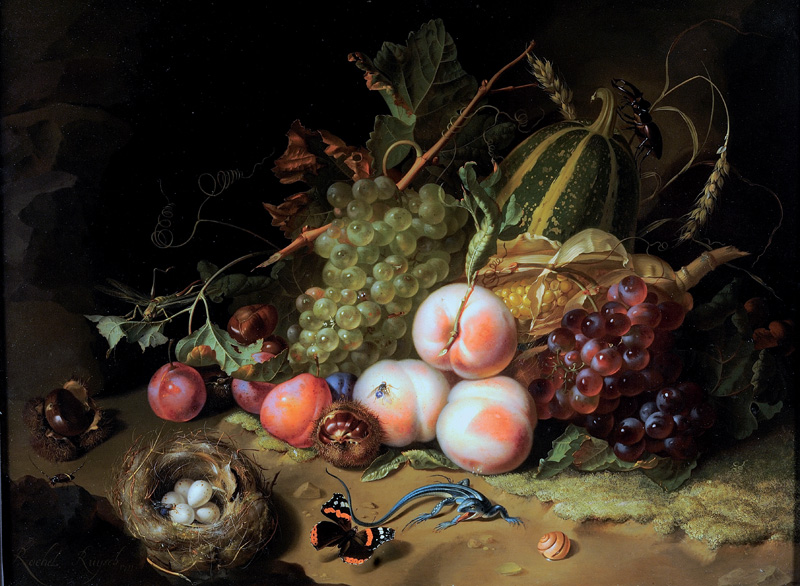Dutch and Northern European Paintings:
Still lifes were a great opportunity to display skill in painting textures and surfaces in great detail and with realistic light effects. Food of all kinds laid out on a table, silver cutlery, intricate patterns and subtle folds in table cloths and flowers all challenged painters. Several types of subject were “banquet pieces” or simpler “breakfast pieces”.[Virtually all still lifes had a moralistic message, usually concerning the brevity of life – this is known as the Vanitas theme – implicit even in the absence of an obvious symbol like a skull, or less obvious one such as a half-peeled lemon (like life, sweet in appearance but bitter to taste). Flowers wilt and food decays, and silver is of no use to the soul. Nevertheless, the force of this message seems less powerful in the more elaborate pieces of the second half of the century.

Vanitas still life painting, very popular among the Dutch, is based on the theme of death’s inevitability. The symbolism of the skulls in this painting is obvious, but the rose (quick to wilt) and oil lamp (easily snuffed out) also refer to life’s brevity and fragility. The vanitas symbolism is underscored by the Latin inscription underneath: “All that is human is smoke, show, vanity and the picture of a stage.” Indianapolis Museum of Art

Vanitas Paintings:
Vanitas Paintings – A Metaphor for Transience
“Society’s awareness of death did not disappear with the end of the Twelve Year Truce; in the 1620s the Republic suffered two outbreaks of Bubonic Plague and this may account for the proliferation in Leiden of Vanitas paintings, whose recurring motif, the skull, was a constant reminder of mortality. Symbolism was present in every form of Still Life but never more significant than in Vanitaswork where everything spoke of ephemerality and the inevitability of death: the watch or hourglass – the passage of time; the overturned glass – the emptiness of life; a violin – the vice of enjoyment, or music fading away; a book – pride in knowledge – an artificial virtue, or history being finished; a smoker’s empty pipe, a guttering candle or smoking oil lamp – life is eventually snuffed out; and airborne soap bubbles were evanescence epitomised. However, there remained as redeeming Christian reference, the chaplet of corn on a skull, a reminder of the Resurrection. Fuchs suggests that this density of morbid symbols would have appealed to the intelligentsia at Leiden University, centre for the study of Calvinism.”
https://dutch.arts.gla.ac.uk/still_life.htm
Image Analysis:

Above is Sir Nathanial Bacon’s ‘Cookmaid with Still Life of Vegetables and Fruit’. This was painted from 1620-5. The paintinf is a landscape of a cookmaid with an arrangement of exotic fruit and vegetables around her and on a table. The backdrop is comprised of outdoor walls and a gap in the walls where a landscape of sky and trees, along with other buildings can be seen.
Curator Tim Batchelor discusses Cookmaid with Still Life of Vegetables and Fruit: TIM BATCHELOR: This striking painting is quite unusual for British art of this period in that it shows quite a lavish still life. Still life painting really becomes established in Britain in the late seventeenth century. NARRATOR: Curator Tim Batchelor. TIM BATCHELOR: The painting also reveals the artist’s interest in gardening and horticulture, the cultivation of plants. This was becoming increasingly fashionable in this period and Nathaniel Bacon took a great interest in this. We have a variety of grape on display here which was a new introduction from America and the melons that we can see prominently displayed near the cook maid herself were grown on his own estates. NARRATOR: Bacon is unusual in being an artist who was of the gentry. His wealth enabling him painted for own pleasure. Not much is known about his training but this painting may hold a clue. TIM BATCHELOR: We know that Nathaniel Bacon travelled in the Southern Netherlands during this period, and that paintings of cookmaids and cookmaid scenes, banquet scenes of this nature, are prevalent in the southern Netherlands, around Antwerp in the late 16 Century and early 17th Century. So he may well travelled there, trained there and become accustomed to this compositional style while he was there.
Sources:
https://www.artsy.net/article/artsy-editorial-dutch-lifes-dark-secrets-hide-exotic-delicacies
https://en.wikipedia.org/wiki/Dutch_Golden_Age_painting#Still_lifes
https://dutch.arts.gla.ac.uk/still_life.htm
https://www.tate.org.uk/about-us/projects/tudor-stuart-technical-research/entries/cookmaid-still-life-vegetables-and-fruit
